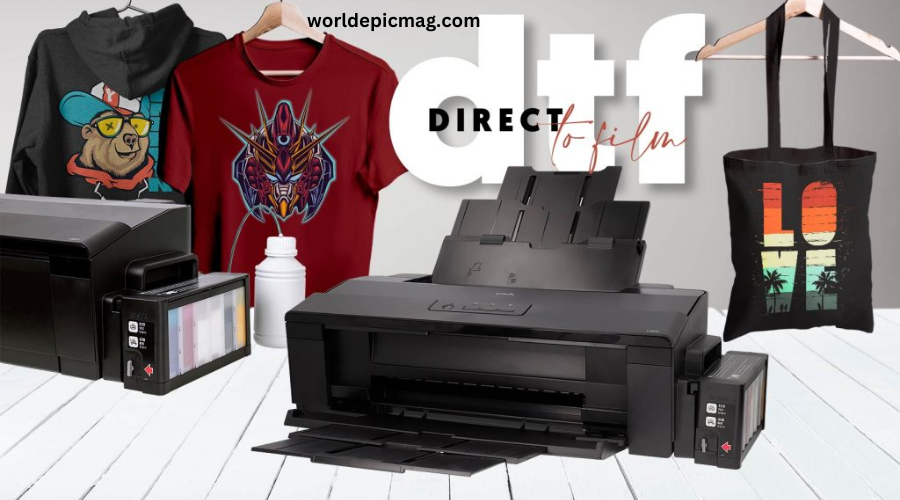Direct-to-Film printing is an innovative method of printing designs onto fabrics, providing high-quality, durable prints. Unlike traditional screen printing or Direct-to-Garment (DTG) printing. DTF allows for greater versatility, making it easier to print on a wider range of materials. Whether you’re printing on cotton, polyester, or other fabrics, DTF Printing delivers sharp, vibrant results with minimal effort.
What is DTF Printing?
DTF printing is a process where designs are printed onto a special film using water-based inks. This film is then transferred onto the fabric using a heat press. With the help of a specially formulated adhesive powder. The result is a highly durable print that is flexible and resistant to wear and tear. Making it ideal for clothing and accessories.
How Does DTF Printing Work?
The printing process involves several steps to ensure a smooth and professional result. Here’s a breakdown of how DTF printing works:
- Design Creation: The first step in printing is creating the design digitally using graphic design software. High-resolution images are essential to achieving a crisp, detailed print.
- Film Printing: Once the design is ready, it is printed onto the DTF transfer film using a specialized DTF. The printer applies water-based inks onto the film in a precise pattern. Ensuring that every detail of the design is captured.
- Adhesive Application: After printing, the film is coated with a powdered adhesive. This adhesive helps bond the ink to the fabric when heat is applied during the transfer process.
- Heat Press Transfer: The printed film, with adhesive applied, is placed on the fabric. Using a heat press machine, heat and pressure are applied to transfer the design from the film onto the fabric. The heat activates the adhesive, ensuring a strong bond between the ink and the fabric.
- Peeling the Film: Once the transfer is complete. The film is peeled away, leaving the design perfectly imprinted on the fabric. The result is a smooth, flexible, and long-lasting print.
Advantages of DTF Printing
DTF offers several benefits, making it a popular choice for businesses, hobbyists, and custom apparel creators. Some key advantages include:
Printing works on a wide range of fabrics, including cotton, polyester, and blends. This versatility makes it a great option for creating custom clothing, accessories, and home textiles. Prints created with DTF technology are highly durable and can withstand multiple washes without fading or cracking. The adhesive bond between the ink and the fabric ensures a long-lasting print.
DTF printing allows for high-resolution designs with vibrant colors. The precision of the printing process ensures that every detail of the design is clearly visible. Unlike screen printing, which requires creating separate screens for each color. Printing is much more cost-effective for smaller print runs. This makes it ideal for custom orders or limited-edition products.
DTF vs. DTG Printing
Both DTF and Direct-to-Garment (DTG) printing are popular methods for printing on textiles, but they differ in several ways:
- Fabric Compatibility: While DTG printing works best on cotton. DTF is more versatile and can be used on a variety of fabrics.
- Durability: DTF prints tend to be more durable than DTG prints. Particularly when it comes to resistance to washing and wear. The adhesive in printing ensures a stronger bond with the fabric.
- Cost: For smaller print runs, DTF printing is generally more affordable than DTG printing. This is because DTF does not require pre-treatment of the fabric, making the process faster and less labor-intensive.
Equipment Needed For DTF Printing
- DTF Printer
- Heat Press Machine
- DTF Transfer Film
- Adhesive Powder
- Design Software
To start with DTF printing, you’ll need a few key pieces of equipment:
A heat press is necessary to transfer the design from the film to the fabric. Heat and pressure help ensure the ink bonds properly with the fabric.
The film is transparent, allowing for precise alignment during the transfer process. The adhesive powder helps bond the ink to the fabric.
How Started With DTF Printing
Starting a DTF printing business or adding this method to your existing apparel printing operations is relatively simple.
- Invest in the Right Equipment: Purchase a high-quality DTF printer, heat press machine, and the necessary transfer films and adhesives. Ensure that your equipment is compatible with the fabrics you plan to print on.
- Learn the Process: While DTF printing is straightforward, it requires some practice to master the technique. Experiment with different fabrics, designs, and heat press settings to get the best results.
- Create Unique Designs: The key to success in DTF printing is creating eye-catching and original designs. Use high-resolution images and creative elements to produce professional-quality prints.
- Market Your Products: Whether you’re offering custom-printed apparel or creating your own clothing line, marketing is essential. Use social media, online stores, and local events to promote your DTF-printed products.
Conclusion
DTF printing is revolutionizing the textile printing industry with its versatility, durability, and cost-effectiveness. Whether you’re printing on cotton, polyester, or a blend of fabrics. DTF offers vibrant, high-quality prints that stand the test of time. With the right equipment and creative designs, DTF printing provides endless opportunities for customization and business growth.
